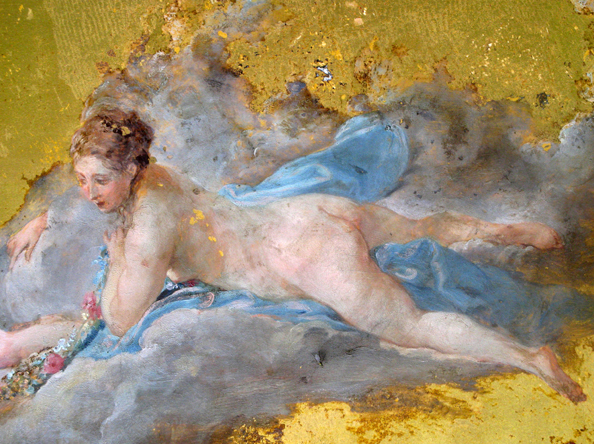![]()
A Franco-Flemish double-manual harpsichord,
![]()
The painting of the recumbent nude on the outside of the lid.
 |
|
|
|
|
Recumbent Female Nude, François Boucher, 1742-1743 Horvitz Collection, Boston Museum of Fine Arts, Boston. As Jessica Priebe has pointed out privately, the placing of both of the arms and legs, and the muscle definition in the front arm, the bare breast and back, the modelling of the buttocks and the close proximity of the front hand to the neck. Other similarities can be seen in the placement of the drapery and the non direct gaze of her face (compared to the fixed gaze of the Odalisque paintings also attributed to Boucher). |
|
Painting of a recumbent female nude, perhaps by one of François Boucher's pupils in about.1752-1755. This figure was added after the initial ravalement and main decoration of the instrument was carried out in 1750. This painting is on the outside of the lid of the Franco-Flemish harpsichord is positioned to the right of the figures of Flora and Juno. The painting of this figure, however, is very impasto in its technique with recognisably-different flesh tones from the rest of the Boucher figures. It does not seem to be by the same painter as the figures of Venus and Cupid and of Flora and Juno. It certainly represents Louis XV's petit maîtresse Marie-Louise O'Murphy, recognisable at the time through such images as that on the left and the one below which were widely-circulated in the Paris salons at the time. So this image would have been instantly recognisable as Louis XV's petit maîtresse. |
|
Painting of the so-called Brown Odalisque by François Boucher, c.1740. Although similar, modern research has shown that this is NOT a painting of Marie-Louise O'Murphy.
Das Alte Pinakothek, Munich
The beautiful chalk drawing at the top left is by François Boucher (1703-1770) who was born, worked and died in Paris. Boucher was a painter, engraver, and designer and his paintings epitomize the Roccoco period. His career was enormously successful and he received many honours, becoming Director of the Gobelin factory in 1755 and then becoming both Director of The Académie and The King's Painter in 1765. He was also the favourite artist of Louis XV's most famous grand maîtresse en titre Madame La Marquise de Pompadour, to whom he gave lessons and whose portrait he painted several times (Wallace Collection, London; National Gallery, Edinburgh; Alte Pinakothek, Munich; Rothschild Collection, Vienna; etc.).
The close resemblance of the three figures seen above strongly suggests that the painting on the outside of the main lid and seen here at the top right is also by Boucher. Clearly the top two figures are of the same model with the same position, pose, modelling, etc in both pictures. However, it is clear from painting layer analysis that the painting on the outside of the lid of the Franco-Flemish harpsichord (top right) is a later addition to the rest of the paintings on the lid of the harpsichord: the paint is thick and pasty, with a definite 'texture' not found on any of the rest of the paintings attributed to Boucher. The painting of the face in particular is not typical of those usually painted by Boucher. Boucher's figures usually have un-naturally widely-spaced eyes and a very wide forehead. Although still only partly cleaned the figure has none of the delicacy of the other nude or semi-nude figures on the rest of instrument, and the flesh tones are noticeably different, even to the naked eye. It seems as though this figure was added sometime later, after the other figures had already been painted onto the top of the lid.
There are other drawings or paintings by Boucher similar to the 1742/3 drawing, and there are other post-1752 figures that are similar to the Munich painting, said to be of Marie-Louise O'Murphy. Whatever the case, the painting on the harpsichord lid is post 1750 and so clearly only the post 1750 Boucher paintings are are relevant here.
However who, other than Louis XV, would have had the King's mistress painted on their harpsichord? It seems impossible to think that anyone would risk the ire of the King by having an image of the King's mistress painted on their instrument! This makes it likely, or at least possible, that the instrument belonged to Louis XV himself! His mistress Marie-Louise O'Murphy (Omorfi as it was transcribed in French) did not become his mistress until about 1752/3 so that it is quite possible that Louis XV (or Madame de Pompadour) had Ms O'Murphy painted onto the instrument at about this time and after the initial vernis martin decoration was given to the instrument by Boucher and Huet in 1750.
Click here for a discussion of the possible ownership of this harpsichord by the royal French court.

